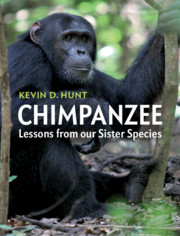Book contents
- Chimpanzee
- Reviews
- Chimpanzee
- Copyright page
- Dedication
- Contents
- Foreword
- Preface
- Acknowledgments
- 1 Sister’s Keeper
- 2 Wild Lesson
- 3 A Most Surprising Creature
- 4 Kin
- 5 Scratching Out a Living in an Unforgiving World
- 6 Guts, Glorious Guts, Large Stomach, and Colon
- 7 Thews, Sinews, and Bone
- 8 Arboreal Gathering, Terrestrial Traveling
- 9 Forged in Nature’s Cauldron
- 10 Up from the Protoape
- 11 Building a Natural Wonder
- 12 The Source of Similarity
- 13 Making Your Way in the Great Wild World
- 14 The Grim Reaper in the Forest Primeval
- 15 Powering Life
- 16 Shelter from the Storm
- 17 Meat-Seeking Missiles
- 18 The Mind of the Chimpanzee
- 19 The Brain of the Chimpanzee
- 20 Tired Nature’s Sweet Restorer
- 21 Chimpanzee Thought Transfer
- 22 Ape Implements
- 23 Wisdom of the Ages
- 24 The Daily Grind
- 25 A Nation at War with Itself
- 26 The Sporting Chimpanzee
- 27 The Passion of Pan
- 28 Into the Light
- 29 The Other Sister, Bonobos
- 30 Sister Species
- Book part
- Index
- Plate Section (PDF Only)
- References
29 - The Other Sister, Bonobos
The Monkey Convergence Hypothesis
Published online by Cambridge University Press: 10 July 2020
- Chimpanzee
- Reviews
- Chimpanzee
- Copyright page
- Dedication
- Contents
- Foreword
- Preface
- Acknowledgments
- 1 Sister’s Keeper
- 2 Wild Lesson
- 3 A Most Surprising Creature
- 4 Kin
- 5 Scratching Out a Living in an Unforgiving World
- 6 Guts, Glorious Guts, Large Stomach, and Colon
- 7 Thews, Sinews, and Bone
- 8 Arboreal Gathering, Terrestrial Traveling
- 9 Forged in Nature’s Cauldron
- 10 Up from the Protoape
- 11 Building a Natural Wonder
- 12 The Source of Similarity
- 13 Making Your Way in the Great Wild World
- 14 The Grim Reaper in the Forest Primeval
- 15 Powering Life
- 16 Shelter from the Storm
- 17 Meat-Seeking Missiles
- 18 The Mind of the Chimpanzee
- 19 The Brain of the Chimpanzee
- 20 Tired Nature’s Sweet Restorer
- 21 Chimpanzee Thought Transfer
- 22 Ape Implements
- 23 Wisdom of the Ages
- 24 The Daily Grind
- 25 A Nation at War with Itself
- 26 The Sporting Chimpanzee
- 27 The Passion of Pan
- 28 Into the Light
- 29 The Other Sister, Bonobos
- 30 Sister Species
- Book part
- Index
- Plate Section (PDF Only)
- References
Summary
The startling contrast between bonobo and chimpanzee societies comes into sharp focus in a story Nahoko Tokuyama tells of the intemperate eagerness of a quartet of young males and the rigid social control several females exercised to restrain them (Angier, 2016). It was in the evening, past the time bonobos normally have settled into their sleeping nests for the night. A female was in estrus her flamboyantly swollen estrous swelling stimulating an unrestrained sexual excitement among four males, including the community’s alpha male. Perhaps these males suspected they were skirting the edges of societal norms as they noisily leapt from branch to branch around the female, displaying erections and disturbing what should have been a time of quiet repose for the group. The males, however, were not interested in repose; the presence of this attractive female was simply too much for them to bear. Their overheated commotion went on and on, seemingly with no end in sight. At last, three high-ranking females had had enough. Exploding from beneath, they attacked the four males, scattering them and then ignominiously banishing three of the four into the night, each yelping in retreat. They surrounded the fourth, the alpha male, seized him, and, ignoring his screams of panic, bit him repeatedly – part of a toe was bitten off completely. As the attack wore on he was at last able to break free from the females and flee into the darkness. He failed to reappear the next day, and the day after that; then his absence extended for an entire week. In fact, he limped back into the group only three weeks later, short both a bit of dignity and a bit of a toe.
- Type
- Chapter
- Information
- ChimpanzeeLessons from our Sister Species, pp. 499 - 516Publisher: Cambridge University PressPrint publication year: 2020
References
- 1
- Cited by

